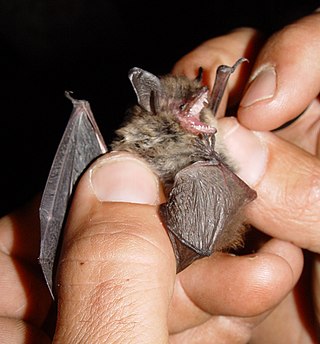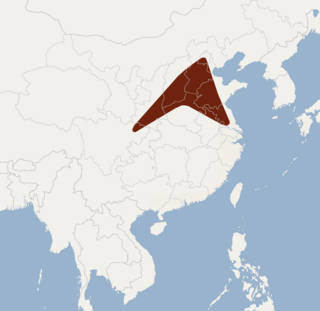
The mouse-eared bats or myotises are a diverse and widespread genus (Myotis) of bats within the family Vespertilionidae. The noun "myotis" itself is a Neo-Latin construction, from the Greek "muós and "oûs", literally translating to "mouse-eared".

Hodgson's bat, also called the copper-winged bat or black-and-orange myotis, is a species of vesper bat in the genus Myotis, the mouse-eared bats. Favouring mountain forests, it is found throughout Central, Southeast, and East Asia, from Afghanistan to Taiwan. It is about 5 centimetres (2.0 in) long and is distinguished from most other species of bat in this range by its yellowish colouration.

The greater mouse-eared bat is a European species of bat in the family Vespertilionidae.
The Ethiopian long-eared bat or Ethiopian big-eared bat is a species of long-eared bat in the family Vespertilionidae.

The large-footed bat, large-footed mouse-eared bat, or large-footed myotis is a species of vesper bat. It can be found in the following countries: Australia, Indonesia, Malaysia, Papua New Guinea, Singapore, Solomon Islands, Taiwan, Vanuatu, and possibly Vietnam.

The fringed long-footed myotis is a species of vesper bat in the family Vespertilionidae. It is found in China, Taiwan and Hong Kong.

The Burmese whiskered myotis or Burmese whiskered bat is a species of vesper bat. It is found in China, India, Myanmar, Laos, and Vietnam.

The Beijing mouse-eared bat or Peking myotis is a species of vesper bat. It is found only in China.

Myotinae is a subfamily of vesper bats. It contains three genera: Eudiscopus, Myotis, and Submyotodon. Before the description of Submyotodon and analysis of its phylogenetics, as well as a phylogenetic analysis of Eudiscopus, the only member of Myotinae was Myotis.
Kock's mouse-eared bat is a species of mouse-eared bat found in the Republic of the Congo.

The eastern water bat or Sakhalin bat is a species of mouse-eared bat. It was for a long time considered to be a subspecies of Myotis daubentonii.

The Bocharic myotis or Bokhara whiskered bat is a species of mouse-eared bat in the family Vespertilionidae, described in 1950, and indigenous to Tajikistan, and Uzbekistan.

The lesser mouse-eared bat or lesser mouse-eared myotis is a species of insectivorous bat in the family Vespertilionidae.

David's myotis is a species of microbat in the Vespertilionidae family native to China, Mongolia, Kazakhstan, and Russia. First identified in 1869 by Wilhelm Peters, it is similar in morphology to species like M. mystacinus, M. ikonnikovi, M. brandtii, and M. sibiricus. It was previously considered to be a subspecies of the whiskered bat.
Myotis diminutus is a species of mouse-eared bat found in Ecuador and Colombia. It was recently described as a new species in 2011.

Myotis izecksohni is a species of mouse-eared bat that is endemic to Brazil and Argentina.

Myotis indochinensis, commonly known as the Indochinese mouse-eared bat, is a species of cave-dwelling bat in the family Vespertilionidae. It is found in Vietnam and China.

Myotis annatessae is a recently described species of bat in the family Vespertilionidae. It is endemic to Vietnam and Laos.
Strelkov's long-eared bat is a species of vesper bat found in mountainous regions of Central Asia.
Ward's long-eared bat is a species of vesper bat in the family Vespertilionidae. It is found in mountainous regions of South Asia and adjoining regions.
















